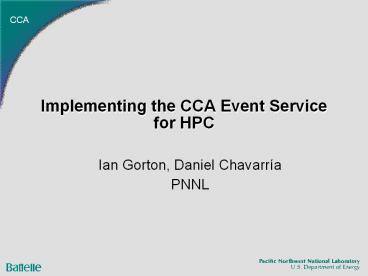Implementing the CCA Event Service for HPC PowerPoint PPT Presentation
1 / 17
Title: Implementing the CCA Event Service for HPC
1
Implementing the CCA Event Service for HPC
- Ian Gorton, Daniel Chavarría
- PNNL
2
CCA Event Service 101
- Publish-subscribe
- 1-n, n-m, n-1
- Specification is similar to
- Java Messaging Service
- Many distributed event/messaging services
3
Possible use cases
- Event/message distribution between components in
the same framework - Initial SciRun implementation
- Event/message distribution across processes in a
HPC application - Across address spaces
- Needs to be fast
- Handle a range of potential payload sizes
- Event/messaging service schizophrenia!!
- Other work exists
- ECho
- Grid event service
4
What weve been working on
- Started with Utah CCA/SciRun event service
implementation - Created two standalone prototypes (no SIDL, no
framework) - Reliable events transferred via files
- Fast events transferred over ARMCI on Cray XD1
- Single-sided memory transfers
5
Cray XD-1
FPGA Node
RapidArray Fabric
ARMCI is part of the vendor-supplied protocol
stack on the XD-1, together with MPI. Both
protocols enable high-bandwidth, low-latency
communication between nodes
Regular Node
6
Polygraph
- Polygraph is a proteomics application developed
at PNNL - Analyzes protein spectra obtained from mass
spectrometry experiments - Each spectrum consists of position and intensity
arrays (100 - 400 entries) - For each input, Polygraph scans a reference
database of several million proteins (FASTA,
multi-GB size) - Generates a list of matching peptides based on
weight (thousands to millions of candidates) - Match list is refined further by computing a
projected spectrum for the reference data point
and assigns it a score based on statistically
generated datasets matching peaks - Top matches are identified for each spectrum
- Profile of the application indicates that 3
routines take 51 of the exec. Time - fpgenerate(), fp_set_hypoth(), fpextract()
7
Our Target PolyGraph/FPGAs
FPGA Accelerator for fpgenerate()
8
ARMCI Prototype
- Goals
- maintain interface/semantics of the event service
model - achieve high performance in a distributed memory
HPC system - Used combination of MPI ARMCI
- MPI - Process 0 operates as a Topic Directory
process - Maintains a Topic List with the locations of the
publishers - Uses an MPI messaging protocol to serve topic
creation requests and queries - ARMCI - Publishers create events locally in their
own address space - Subscribers read remote events from the
publishers using one-sided ARMCI_Get() operations
- no need for coordination with the publisher
9
ARMCI Prototype (cont.)
- Used a combination of MPI ARMCI to create the
event service - Transfer C class instances directly over ARMCI
without the need for type serialization - Events comprise two TypeMaps header and body
- Created a special heap manager for the ARMCI
address space - objects can be allocated directly through
standard new() and delete() operators - synchronous garbage collection by the publisher
- For high performance, all objects in the ARMCI
heap are flattened - no pointers or references to external objects
- member variables embedded
- fixed size
10
Initial Performance Results
- We measured event processing rates
- 66K events/second with one publisher/one
subscriber (small event 4KB) - 950 events/second with one publisher/16
subscribers (large event 50KB) - Minimal overhead to reconstruct the object on the
subscriber after the transfer
11
Analysis
- Performance drops as number of subscribers
increases - Contention for events at publisher ARMCI memory
- Alternatives implementations are possible
- Maintain topics for subscribers only in local
ARMCI memory - Publishers write to subscriber memory directly
for each event published
12
Alternative Design
Maintain topic list in process 0 (using MPI) or
ARMCI shared memory?
Send()
Weaknesses? Publish can fail if subscriber memory
full Some subscribers slower than others - events
delivered unpredictably depending on consumption
rate
Strengths? Likely reduced contention Simplifies
publish semantics and event retention issues
13
Polygraph Issues Delivery Semantics
- Basic pub-sub good for N-to-N event distribution
- Need to keep events until all subscribers consume
them - Optional time-to-live in header can help
- Workload distribution use cases require
load-balancing topics - Same programmatic interface
- Each event consumed by only one subscriber
- No complex event retention issues
- Could define load-balancing policies for
publishers - Declaratively?
- A one-to-one queue-like mechanism may also be
useful?
14
Issues Topic Memory Management
- Managing memory for a topic is tricky
- Need to know how many subscribers for each
specific event - Events are variable size, hence
allocating/reclaiming memory for events is
complex - One possibility typed topics
- Associate an event type with a topic
- Specify maximum size for any event
- Simplifies memory management for each topic
15
Issues - Miscellaneous
- What are semantics when a new subscriber
subscribes to a topic? - What exactly do they see?
- All messages in topic queue at subscription time?
- Only new ones?
- In ARMCI implementation, memory for topic queues
is finite - Should it be user-configurable?
- What happens when topic memory full?
- Standard publish error defined by Event Service?
16
Issues - Miscellaneous
- Event Service SIDL doesnt clearly demarcate if
there are - Calls for publishers only?
- Calls for subscribers only?
- So what happens if
- A publisher calls ReleaseTopic()?
- A publisher calls ProcessEvents()?
- How can CreateTopic() fail?
- Two publishers call CreateTopic in a
non-deterministic sequence. What happens? - Can a subscriber call CreateTopic()?
- Why is argument to ReleaseTopic() a string?
- Would a valid Topic reference be less
error-prone/simpler? - Should events have a standard header
- Used by all event service implementations
- Not settable programmatically
- E.g. Time-to-live, timestamp, correlation-id,
likely others
17
Next steps
- Implement alternative subscriber side ARMCI
implementation - Detailed performance analysis
- Use Event Service to implement PolyGraph use case

